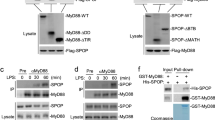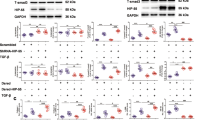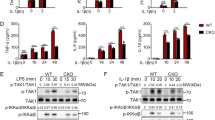Abstract
Transforming growth factor-β1 (TGF-β1) is a potent cytokine with pleiotropic effects, including anti-inflammatory activity. Here we show that the signaling protein Smad6 bound to Pellino-1, an adaptor protein of mammalian interleukin 1 receptor (IL-1R)–associated kinase 1 (IRAK1), and thereby promoted TGF-β-mediated anti-inflammatory effects. Smad6–Pellino-1 interaction abrogated signaling mediated by a complex of IRAK1, Pellino-1 and adaptor protein TRAF6 that formed after stimulation by IL-1β treatment. Blockade of IRAK1–Pellino-1–TRAF6 signaling prevented degradation of the inhibitor IκBα and subsequent nuclear translocation of transcription factor NF-κB and thus expression of proinflammatory genes. 'Knockdown' of endogenous Smad6 expression by RNA interference reduced anti-inflammatory activity mediated by TGF-β1 or the TGF-β family member BMP-4. Thus Smad6 is a critical mediator of the TGF-β–BMP pathway that mediates anti-inflammatory activity and negatively regulates IL-1R–Toll-like receptor signals.
This is a preview of subscription content, access via your institution
Access options
Subscribe to this journal
Receive 12 print issues and online access
$209.00 per year
only $17.42 per issue
Buy this article
- Purchase on SpringerLink
- Instant access to full article PDF
Prices may be subject to local taxes which are calculated during checkout







Similar content being viewed by others
References
Roberts, A.B. & Sporn, M.B. Physiological actions and clinical applications of transforming growth factor-β (TGF-β). Growth Factors 8, 1–9 (1993).
Whitman, M. Smads and early developmental signaling by the TGF-β superfamily. Genes Dev. 12, 2445–2462 (1998).
Blobe, G.C., Schiemann, W.P. & Lodish, H.F. Role of transforming growth factor-β in human disease. N. Engl. J. Med. 342, 1350–1358 (2000).
de Caestecker, M.P., Piek, E. & Roberts, A.B. Role of transforming growth factor-β signaling in cancer. J. Natl. Cancer Inst. 92, 1388–1402 (2000).
Hayashi, H. et al. The MAD-related protein Smad7 associates with the TGF-β receptor and functions as an antagonist of TGF-β signaling. Cell 89, 1165–1173 (1997).
Imamura, T. et al. Smad6 inhibits signalling by the TGF-β superfamily. Nature 389, 622–626 (1997).
Nakao, A. et al. Identification of Smad7, a TGF-β-inducible antagonist of TGF-β signalling. Nature 389, 631–635 (1997).
Monteleone, G. et al. Blocking Smad7 restores TGF-β1 signaling in chronic inflammatory bowel disease. J. Clin. Invest. 108, 601–609 (2001).
Dong, C. et al. Deficient Smad7 expression: a putative molecular defect in scleroderma. Proc. Natl. Acad. Sci. USA 99, 3908–3913 (2002).
Asano, Y., Ihn, H., Yamane, K., Kubo, M. & Tamaki, K. Impaired Smad7-Smurf–mediated negative regulation of TGF-β signaling in scleroderma fibroblasts. J. Clin. Invest. 113, 253–264 (2004).
Kavsak, P. et al. Smad7 binds to Smurf2 to form an E3 ubiquitin ligase that targets the TGF-β receptor for degradation. Mol. Cell 6, 1365–1375 (2000).
Ebisawa, T. et al. Smurf1 interacts with transforming growth factor-β type I receptor through Smad7 and induces receptor degradation. J. Biol. Chem. 276, 12477–12480 (2001).
Murakami, G., Watabe, T., Takaoka, K., Miyazono, K. & Imamura, T. Cooperative inhibition of bone morphogenetic protein signaling by Smurf1 and inhibitory Smads. Mol. Biol. Cell 14, 2809–2817 (2003).
Ulloa, L., Doody, J. & Massague, J. Inhibition of transforming growth factor-β/SMAD signalling by the interferon-γ/STAT pathway. Nature 397, 710–713 (1999).
Bitzer, M. et al. A mechanism of suppression of TGF-β/SMAD signaling by NF-κB/RelA. Genes Dev. 14, 187–197 (2000).
Topper, J.N. et al. Vascular MADs: two novel MAD-related genes selectively inducible by flow in human vascular endothelium. Proc. Natl. Acad. Sci. USA 94, 9314–9319 (1997).
Bai, S., Shi, X., Yang, X. & Cao, X. Smad6 as a transcriptional corepressor. J. Biol. Chem. 275, 8267–8270 (2000).
Bai, S. & Cao, X. A nuclear antagonistic mechanism of inhibitory Smads in transforming growth factor-β signaling. J. Biol. Chem. 277, 4176–4182 (2002).
Lin, X. et al. Smad6 recruits transcription corepressor CtBP to repress bone morphogenetic protein-induced transcription. Mol. Cell. Biol. 23, 9081–9093 (2003).
Grosshans, J., Schnorrer, F. & Nusslein-Volhard, C. Oligomerisation of Tube and Pelle leads to nuclear localisation of dorsal. Mech. Dev. 81, 127–138 (1999).
Jiang, Z. et al. Pellino 1 is required for interleukin-1 (IL-1)-mediated signaling through its interaction with the IL-1 receptor-associated kinase 4 (IRAK4)-IRAK tumor necrosis factor receptor-associated factor 6 (TRAF6) complex. J. Biol. Chem. 278, 10952–10956 (2003).
Yu, K.Y. et al. Cutting edge: mouse pellino-2 modulates IL-1 and lipopolysaccharide signaling. J. Immunol. 169, 4075–4078 (2002).
Jensen, L.E. & Whitehead, A.S. Pellino3, a novel member of the Pellino protein family, promotes activation of c-Jun and Elk-1 and may act as a scaffolding protein. J. Immunol. 171, 1500–1506 (2003).
Janeway, C.A., Jr. & Medzhitov, R. Innate immune recognition. Annu. Rev. Immunol. 20, 197–216 (2002).
Akira, S., Takeda, K. & Kaisho, T. Toll-like receptors: critical proteins linking innate and acquired immunity. Nat. Immunol. 2, 675–680 (2001).
Kimbrell, D.A. & Beutler, B. The evolution and genetics of innate immunity. Nat. Rev. Genet. 2, 256–267 (2001).
Dinarello, C.A. Interleukin-1, interleukin-1 receptors and interleukin-1 receptor antagonist. Int. Rev. Immunol. 16, 457–499 (1998).
O'Neill, L. The Toll/interleukin-1 receptor domain: a molecular switch for inflammation and host defense. Biochem. Soc. Trans. 28, 557–563 (2000).
Martin, M.U. & Wesche, H. Summary and comparison of the signaling mechanisms of the Toll/interleukin-1 receptor family. Biochim. Biophys. Acta 1592, 265–280 (2002).
Afrakhte, M. et al. Induction of inhibitory Smad6 and Smad7 mRNA by TGF-β family members. Biochem. Biophys. Res. Commun. 249, 505–511 (1998).
Maric, I. et al. Bone morphogenetic protein-7 reduces the severity of colon tissue damage and accelerates the healing of inflammatory bowel disease in rats. J. Cell. Physiol. 196, 258–264 (2003).
Jensen, L.E. & Whitehead, A.S. Pellino2 activates the mitogen activated protein kinase pathway. FEBS Lett. 545, 199–202 (2003).
Dinarello, C.A. Biologic basis for interleukin-1 in disease. Blood 87, 2095–2147 (1996).
Medzhitov, R. Toll-like receptors and innate immunity. Nat. Rev. Immunol. 1, 135–145 (2001).
Takeda, K., Kaisho, T. & Akira, S. Toll-like receptors. Annu. Rev. Immunol. 21, 335–376 (2003).
O'Neill, L.A. & Dinarello, C.A. The IL-1 receptor/Toll-like receptor superfamily: crucial receptors for inflammation and host defense. Immunol. Today 21, 206–209 (2000).
Poltorak, A. et al. Defective LPS signaling in C3H/HeJ and C57BL/10ScCr mice: mutations in Tlr4 gene. Science 282, 2085–2088 (1998).
Lorenz, E., Mira, J.P., Frees, K.L. & Schwartz, D.A. Relevance of mutations in the TLR4 receptor in patients with Gram-negative septic shock. Arch. Intern. Med. 162, 1028–1032 (2002).
Aliprantis, A.O. et al. Cell activation and apoptosis by bacterial lipoproteins through Toll-like receptor-2. Science 285, 736–739 (1999).
Hou, L., Sasaki, H. & Stashenko, P. Toll-like receptor 4-deficient mice have reduced bone destruction following mixed anaerobic infection. Infect. Immun. 68, 4681–4687 (2000).
Cook, D.N., Pisetsky, D.S. & Schwartz, D.A. Toll-like receptors in the pathogenesis of human disease. Nat. Immunol. 5, 975–979 (2004).
McCartney-Francis, N., Jin, W. & Wahl, S.M. Aberrant Toll receptor expression and endotoxin hypersensitivity in mice lacking a functional TGF-β1 signaling pathway. J. Immunol. 172, 3814–3821 (2004).
Neumann, D., Kollewe, C., Martin, M.U. & Boraschi, D. The membrane form of the type II IL-1 receptor accounts for inhibitory function. J. Immunol. 165, 3350–3357 (2000).
Brint, E.K. et al. ST2 is an inhibitor of interleukin 1 receptor and Toll-like receptor 4 signaling and maintains endotoxin tolerance. Nat. Immunol. 5, 373–379 (2004).
Wald, D. et al. SIGIRR, a negative regulator of Toll-like receptor-interleukin 1 receptor signaling. Nat. Immunol. 4, 920–927 (2003).
Kobayashi, K. et al. IRAK-M is a negative regulator of Toll-like receptor signaling. Cell 110, 191–202 (2002).
Burns, K. et al. Inhibition of interleukin 1 receptor/Toll-like receptor signaling through the alternatively spliced, short form of MyD88 is due to its failure to recruit IRAK-4. J. Exp. Med. 197, 263–268 (2003).
Kinjyo, I. et al. SOCS1/JAB is a negative regulator of LPS-induced macrophage activation. Immunity 17, 583–591 (2002).
Naiki, Y. et al. Transforming growth factor-β differentially inhibits MyD88-dependent, but not TRAM- and TRIF-dependent, lipopolysaccharide-induced TLR4 signaling. J. Biol. Chem. 280, 5491–5495 (2005).
Kawai, T. et al. Unresponsiveness of MyD88-deficient mice to endotoxin. Immunity 11, 115–122 (1999).
Ju, E.M. et al. Apoptosis of mink lung epithelial cells by co-treatment of low-dose staurosporine and transforming growth factor-β1 depends on the enhanced TGF-β signaling and requires the decreased phosphorylation of PKB/Akt. Biochem. Biophys. Res. Commun. 328, 1170–1181 (2005).
Kim, B.C. et al. Jab1/CSN5, a component of the COP9 signalosome, regulates transforming growth factor-β signaling by binding to Smad7 and promoting its degradation. Mol. Cell. Biol. 24, 2251–2262 (2004).
Fujii, M. et al. Roles of bone morphogenetic protein type I receptors and Smad proteins in osteoblast and chondroblast differentiation. Mol. Biol. Cell 10, 3801–3813 (1999).
Kim, B.C., Mamura, M., Choi, K.S., Calabretta, B. & Kim, S.J. Transforming growth factor-β1 induces apoptosis through cleavage of BAD in a Smad3-dependent mechanism in FaO hepatoma cells. Mol. Cell. Biol. 22, 1369–1378 (2002).
Park, S.H. et al. Mechanism of induction of transforming growth factor-β type II receptor gene expression by v-Src in murine myeloid cells. Cell Growth Differ. 12, 9–18 (2001).
Cardosa, M.J., Gordon, S., Hirsch, S., Springer, T.A. & Porterfield, J. Interaction of West Nile Virus with primary murine macrophage: Role of cell activation and receptors for antibody and complement. J. Virol. 57, 952–959 (1986).
Acknowledgements
We thank G. Merlino and A. Hobbie for critical reading of the manuscript. Supported by Korea Research Foundation Grant funded by the Korean Government (KRF-2003-015-C00528 to S.H.P.; laboratory equipment, R08-2003-000-10077-0 to S.H.P.), the intramural research fund of the National Cancer Center of Korea (C.-H.L. and I.-H.K) and the Intramural Research Program of the National Cancer Institute.
Author information
Authors and Affiliations
Contributions
K.-C.C., Y.S.L., S.L., H.K.C., C.-H.L., E.-K.L. and S.H. did the experimental work and analyzed data; I.-H.K. participated in the study design; S.H.P. and S.-J.K. designed and conceptualized the research, supervised the experimental work, analyzed data and wrote the manuscript.
Corresponding authors
Ethics declarations
Competing interests
The authors declare no competing financial interests.
Supplementary information
Supplementary Fig. 1
Smad6 inhibits the expression of the NF-κB-promoter reporter induced by LPS in RAW264.7 cells. (PDF 687 kb)
Supplementary Fig. 2
Schematic representation of Smad6 'knockdown' plasmid (pU6-siSmad6) by siRNA. (PDF 757 kb)
Supplementary Fig. 3
Inhibition of endogenous Pellino-1 by siRNA abrogates NF-κB activation induced by IL-1β treatment. (PDF 711 kb)
Supplementary Fig. 4
Stable expression of Peli1 siRNA decreases NF-κB activation upon treatment of IL-1β. (PDF 186 kb)
Supplementary Fig. 5
LPS induced IRAK1-mediated signaling complexes are disrupted by pre-treatment with TGF-β1. (PDF 201 kb)
Supplementary Fig. 6
IL-1β-induced endogenous TRAF6-mediated signaling complexes are disrupted by pre-treatment with TGF-β1. (PDF 199 kb)
Supplementary Fig. 7
Models for the negative regulation of IL-1R–TLR signaling by Smad6. (PDF 201 kb)
Supplementary Table 1
Primer sequences. (PDF 33 kb)
Rights and permissions
About this article
Cite this article
Choi, KC., Lee, Y., Lim, S. et al. Smad6 negatively regulates interleukin 1-receptor–Toll-like receptor signaling through direct interaction with the adaptor Pellino-1. Nat Immunol 7, 1057–1065 (2006). https://doi.org/10.1038/ni1383
Received:
Accepted:
Published:
Issue Date:
DOI: https://doi.org/10.1038/ni1383



